#SavetheAmazon? – A Case Study of Misinformation across Social Media Reactions to the Amazon Rainforest Fires.
By logging online in August 2019, one is immediately exposed to blazing fires both in the Amazon and across social media. Fires across the Amazon rainforest caused uproar online with many unknowingly re-sharing images that did not depict current events but were taken years prior. Misinformation is thus brought to the forefront of debate.
We have tracked the trajectory of an image tweeted by Macron and exposed to millions, in an attempt to understand how and why misinformation is spread across social media. Macron did not claim the photo to be a broadcast of the current fires, however this did not prevent his audience interpreting and sharing it as such. Macron’s tweet acted as a catalyst for the sharing of misinformation.
Through engaging with academic discussions of actor-network theory, affordances and stakeholders, motivations behind and the implications of misinformation are revealed. This article is comprised of a comprehensive engagement with the coverage of the 2019 Amazon rainforest fires which resolves many areas of uncertainty. How do the affordances of Twitter distribute misinformation? Why do users believe and spread misinformation? And is there anything that can be done to mitigate this pattern?
Misinformation – why we should be concerned
Traditional media plays a crucial role as the “fourth branch of government” in gathering and transmitting information during times of natural disaster, through the use of acoustic and visual productions such as videos, images, and recordings from journalistic reports (Miller and Goidel 266). Nowadays, with the help of distributed network in social media, the ephemerality of infographic materials from unprofessional journalistic work blurs the boundary between factual news and unprofessional pieces from individuals who attempt to spread information in regards to natural disasters. Fact check is very limited in a rapid speed internet; online weak-tie relations between followers, organizations/celebrities and hyperlinks accelerate the circulation of content.
This phenomenon leads to a higher possibility of the spread of misinformation that is easily accessible for every single person. Most significantly, an enormous amount of digital misinformation is becoming pervasive in online social media to the extent that it has been listed by the World Economic Forum (WEF) as one of the main threats to our society. In academic context, misinformation is defined as false information that is created and forwarded spontaneously by people who intentionally or unintentionally take the action (Wu et al. 3). When it comes to consequences of false information in the spread of natural disaster, online fake news of such is incarnated as images and texts which cause anxiety, distress, panic and even social instability, especially within communities located in areas where the rate of natural disasters is high (Lamb, Lyons). Moreover, the increasing awareness of global warming encourages online users who are concerned about this issue to distribute relevant content in a larger scale across continents. In the process of news circulation, misinformation can be used by different stakeholders for various purposes (Miller and Goidel 266).
The Amazon rainforest fires
August 2019 witnessed a surge in the rate of forest fires in the Amazon Rainforest. The Amazon experiences annual fires during the dry season so whilst the fires must not be considered an abnormality, the increased rate does raise concern. The swell in amount of fires can be traced back to higher average temperatures, observed as a consequence of climate change. Fires release dangerous chemical compounds into the atmosphere and catalyse devastating impacts on both the biodiversity and indigenous communities of which the Amazon is home. Additionally, the Amazon as a natural reservoir plays a crucial role in providing the Earth with a supply of oxygen and mitigating global warming (BBC).
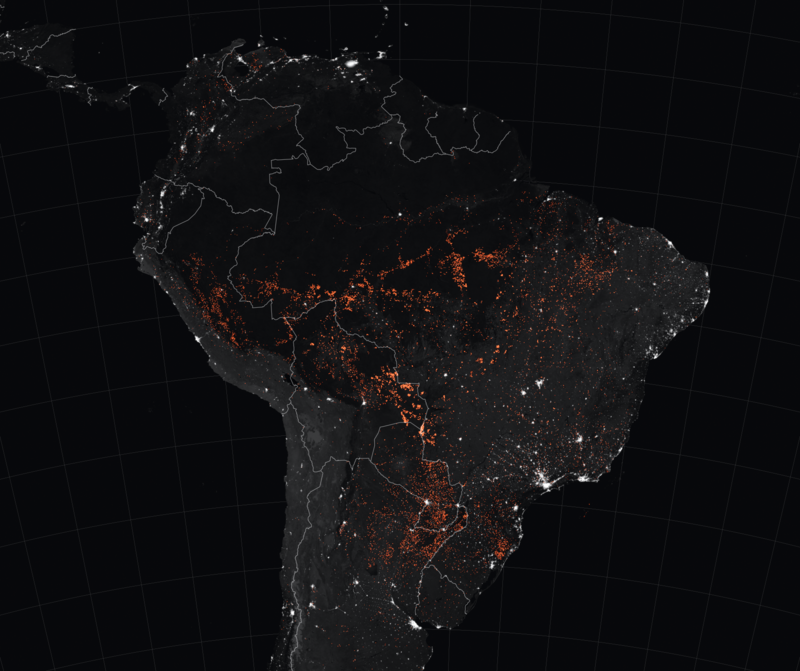
Figure 1: Satellite photo taken by the NASA between Aug. 15-22, 2019
(Image: © NASA Earth Observatory/Joshua Stevens)
Brazil’s National Institute for Space Research first detected the increased rate of fire through their satellite monitoring. The news story quickly gained momentum across news channels and social media with many high-profile celebrities sharing images and encouraging their followers to contribute to the cause through either actions or financial donations. The social media response mirrored many other post-trauma reactions. There is a tendency for events of crisis to draw people to their online platforms in order to raise awareness, express their devastation and frustration and to consolidate support.
The issue of misinformation holds relevance in this context because many of the photos being shared online were images taken years prior to the event in discussion, some in locations other than the Amazon. Of note was French President, Emmanuel Macron’s tweet accompanied by an image which can be traced back to the photographer Loren McIntyre who died in 2003, 16 years prior to the fires being discussed. Macron has 4.2 million Twitter followers and this tweet of his received over 161 thousand likes and 58 thousand re-tweets (@EmmanuelMacron). The image was also used on multiple occasions by the French government for their coverage of the fires even after the origins of the photo were revealed.
Our investigative research approach
Our main goal was to observe the way the misleading photo had spread on the Internet and to what extent. We decided to take on a mixed-methods approach. We combined quantitative data collection, collecting quantifiable information: tweets and URLs, with a qualitative type of analysis, where we looked at the way the photo had been modified to fit specific narratives.
We primarily used two methods to collect data and to achieve our goal of tracing the photo. The first tool we used was Google reverse image search, where we uploaded the said photo. The search gave us over 25 billion results, which was too great of a number for us to analyze. For that reason, we filtered out the results by date from August 22nd of this year, which is the day Macron published the tweet containing the photo to October 10th, which is the day we conducted the research.
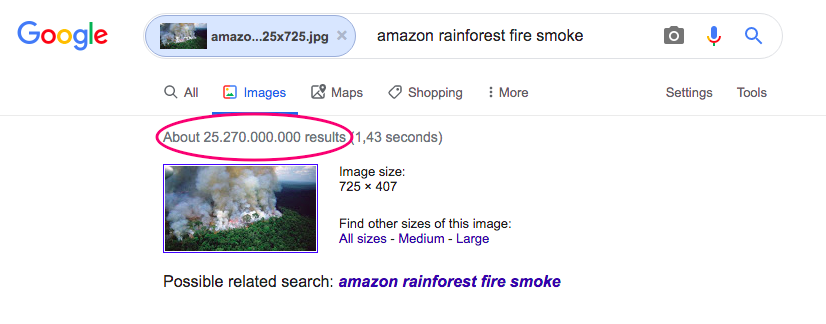
From this new refined search, we decided to analyze the first 20 result pages, which gave us 200 results. We then copied and pasted the content of each of those 20 pages into the Digital Methods Initiative’s Harvester tool to extract URLs from the rest of the text. Finally, we organized the data in an excel sheet, ordering each link by number of appearances.
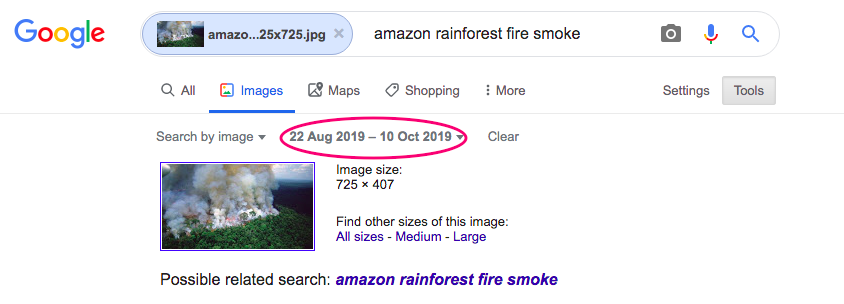
We directly used Twitter for our second data collection method, as we were on the lookout for tweets containing our chosen media object, the much talked about photo. We took two different approaches to maximize our chances of success.
The first technique consisted in scrolling through the feed until we found the photo. In order to do so, we narrowed down the amount of tweets by the use of adequate hashtags (#PrayforAmazonas, #ActfortheAmazon, #SavetheAmazon and #amazonfire). To keep the study relevant and feasible, we decided to only pick the tweets of users who had at least 5,000 followers at the time of data collection.
For the second technique, we used the platform’s advanced search option, which allowed us to directly look into the feed of specific individuals. We first searched for the most followed Twitter accounts, filtering by the same date range we used for the Google reverse image search. We also used Macron’s following list to see if any of his more “direct” connections had retweeted the photo.
Reverse Google image search
The reverse Google image search produced a list of 200 links upon which the photo could be found online. Analysis of the results revealed a handful of websites that appeared multiple times throughout the list. Figure 5 draws attention to how many times each website appeared, with majority of websites appearing once (shown in red). The most frequently a website occurred was six times (shown in blue).
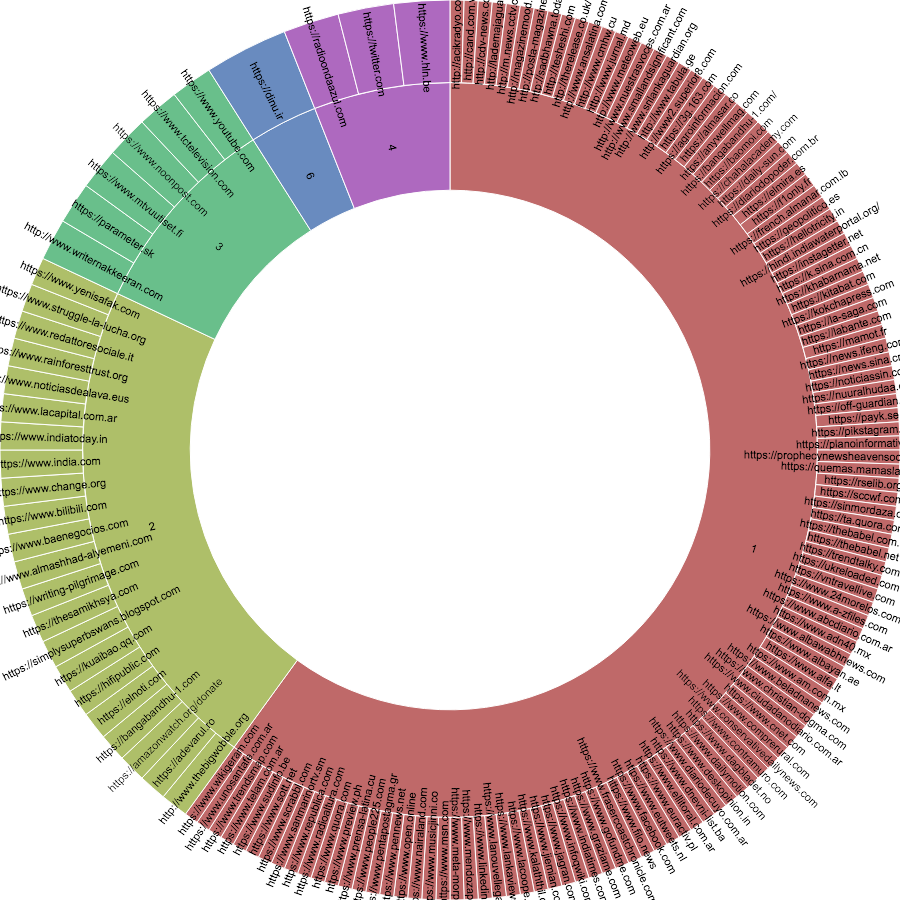
Hyperlinks, which can be understood as internet infrastructure that direct content and distribute information online in a simply click, help facilitate the circulation of misinformation. The affordances of the internet results in a proliferation of user-generated content (Bonegru, Gray).
The map in Figure 6 illustrates the distribution of the links worldwide. It is interesting to see how far the photo has ‘travelled’; for only 200 results out of thousands we can already see a great diversity in the way countries are represented. By extracting the region-specific domains from their URLs, we observed 35 regions or countries represented across Europe, Asia, Australia and the Americas. However, seven generic top level domains also appeared, for example .com (Country Domains: A Comprehensive CcTLD List). The 96 uses of generic top level domains comprise nearly half of the data set and cannot be immediately allocated a geographic location however the data that has been mapped reveals a global dispersion. Consequently it can be argued that misinformation originating from one source has effectively spread across the world, reaching and likely influencing the lives of many therefore achieving a global presence.
Top Twitter users
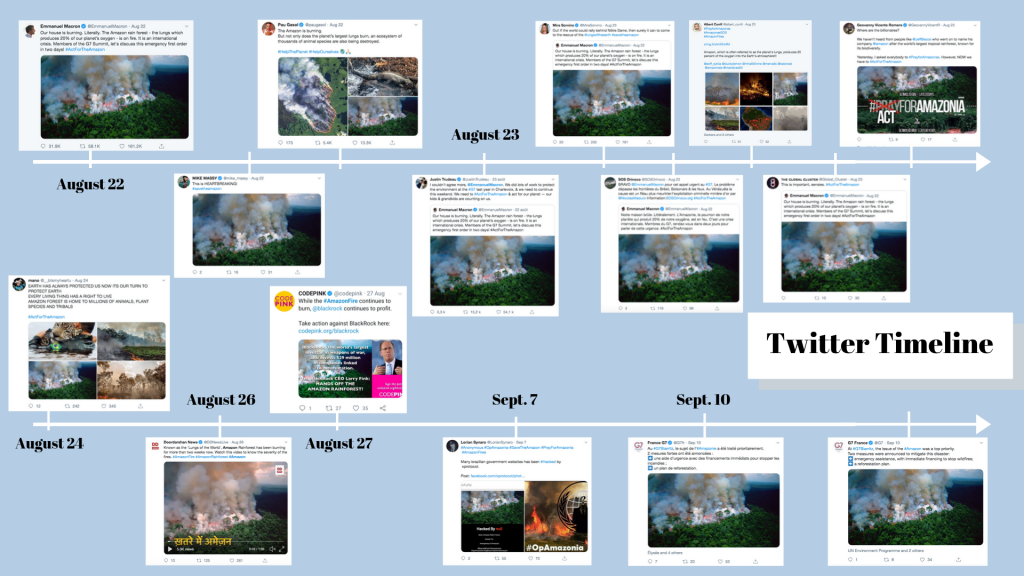
Application of a lens of ‘uptake’, the act “in which one participant takes up another’s contribution and does something further with it” (Rathnayake, Suthers), among the collected tweets revealed an adaption of the image to fit individuals’ motives. Out of the 14 tweets (excluding Macron’s), four were retweets from Macron’s original post, three contained the original image by itself, three featured the photo along with other photos ‘representing’ the event in a collage, one used the photo in a video, and three additional tweets featured a type of edit, including either text, images or both. It is specifically these latter tweets in which ‘uptake’ can be observed. The image was taken and adapted to represent the user’s viewpoint. For instance, @CODEPINK used the Amazon rainforest photo alongside the portrait of BlackRock’s CEO, Laurence Fink, to promote a campaign against his company.
As figure 8 shows, with 73,000, Politicians received the most retweets of the Amazon image across Twitter. Environmental activists received the second most retweets followed by athletes. Here, it is fair to say that news as “the fourth branch of government” resides heavily in the credibility of political institutions or organizations. Since many political entities are using Twitter accounts to inform their plans in relation to ideological propagation and to interact with a wider range of voters, online Twitter users are more likely to retweet environmental content which is posted by their preferred politicians. The image contributes authenticity to the awareness of environmental issues which are also concerned within the working framework of environmental activists. Sports and entertainment celebrities became ‘opinion leaders’; the content they share guides the concern of their followers. If an individual has gathered a large social following there is an expectancy that they will use their influence to spread awareness.
The credibility of the image is no longer a criteria for retweets. However, individual intentions for retweeting are hard to trace. It is difficult for those who shared the image to identify the actual date when the photo was taken. This is problematized in Bruno Latour’s concept of an actor-network theory which determines the affordances of digitality in the process of distribution of the image. According to Latour, “the expansion of digitality has enormously increased the material dimension of network: the more digital, the less virtual and the more material a given activity becomes” (8). The use of hashtags in addressing topics facilitate the distribution of misinformation. It functions as a means of coordinating a distributed discussion among a large range of users while providing explanations of emergence of such ‘hashtag publics’(21) including #SaveTheAmazon. This advantage of hashtag algorithms can be seen in the consequences of actor-network theory that “individual actions is much distributed than just interactions”(13). Thus, the public retweets by the top users’ followers presents a distributive matrix that help the image spread over the internet in a rapid speed. As figure 9 articulates, there is a global range of distribution of the collected tweets across continents. The stakeholders are mainly from countries such as Canada, the United States of America, France, Spain, India, Pakistan and Venezuela.
The significance of misinformation distribution

country, the amount of times the tweet was retweeted, liked and commented, and the tweet type.
Stakeholder communication is unfortunately, where misinformation can be generated due to its function as an intermediary mediating actions between different people.. And the dissemination of misinformation is exacerbated through social media channels such as Twitter, instrumental to our data analysis.
It is first relevant to speak about stakeholder communication with relation to the case of the Amazon rainforest fires. Stakeholders all have their own needs, and it is imperative that each of these needs, are addressed independently. Through addressing these needs, misinformation could crop up as a problem at multiple levels. Stecula mentions how young people have a hard time discerning “good sources of information from questionable ones or determining if a photograph is authentic of fabricated.” Macron here, acts as one intermediary, while lay people may lack the critical assessment skills to spot misinformation, some may have high profile followers, as illustrated by Figure 10. For instance, the laypeople Macron communicate with through Twitter are separate and privileged as they are divorced from the situation at hand. Whereas people such as farmers and indigenous communities of the Amazon rainforest know that the Amazon and surrounding area regularly burn all year round.
So it begs the question, if Macron was communicating to different stakeholders in order to facilitate help/raise awareness using his high-profile Twitter account and status in the political world, why did he not firstly fact-check the picture’s genesis? Could he have brought awareness to the issue sooner and if so would misinformation concerning the issue been stopped if he had fact-checked? Especially as a President, he has the political knowledge and power to help stem misinformation from circulating and should be constantly be conscious and aware of it.
Secondly, the cases of the dissemination of information through social media is also important. Social media, namely Twitter, can disseminate information to a wide and varied user base with great ease. Abdullah et al mention how Twitter is now considered “news media” as it is seen as less social than other social media platforms (33), thus facilitating people’s trust in the platform to convey “trustworthy information.” But it can also encourage the spread of misinformation as shown through our data analysis through the spread of Macron’s tweet being retweeted by several high-profile accounts eg: Doordarshan News. People might assume these pictures/tweets are coming from credible sources, but people should be critical about the content they encounter, which is the important message of this post. Abdullah et al mention how “According to Shibutani [30], rumour is generated if the demand of news is high, but supply is low”(33) meaning misinformation could be generated if people lack critical and important relevant information about the news they are encountering. Scheufele and Krause also mentions how active and misinformed people pose the greatest threat to information, especially when that person is political, like Macron (7).
Concluding thoughts
Misinformation spreads like wildfire. The omnipresence of online platforms and social media and the rate at which information is shared make this issue seem insoluble. Moreover, the actor-network theory of “hashtags” and hyperlinks that are used to jump from website to another play an important role in the circulation of misinformation.
However, many entities actively try to fight misinformation. Among them are nonpartisan, nonprofit organizations, independent schools, and of course newspapers and journalists, whose responsibility is to “present an accurate, well-balanced explanation of the stories they cover” (Williams). Even private companies such as Facebook try to play a role in fixing this issue (Hearn).
That being said, it is of course on a personal level that individuals need to decide to be mindful and critical towards the avalanche of information that is shared online everyday. It is a matter of taking the time and putting in the effort not to fall into the trap of misinformation.
Bibliography
Abdullah, Athiyah Nor, et al. “User’s Action and Decision Making of Retweet Messages towards Reducing Misinformation Spread during Disaster.” Journal of Information Processing, vol.23,no.1,2015, pp. 31-40. https://www.bbc.co.uk/news/world-latin-america-49415973.
BBC. “Amazon Fires ‘Increase 84% In One Year'”. BBC News, 2019,
Bounegru, Liliana, and Jonathan Gray. ‘New Guide Helps Journalists, Researchers Investigate Misinformation, Memes and Trolling’. First Draft, 8 Jan. 2018, https://firstdraftnews.org:443/field-guide-fakenews-infodisorders/.
Bruno Latour. Networks, Societies, Spheres: Reflections of an Actor-Network Theorist. International Seminar On Network Theory: Network Multidimensionality In The Digital Age, Feb 2010, Annenberg School for Communication and Journalism, Los Angeles, United States.
‘Country Domains: A Comprehensive CcTLD List’. IONOS Digitalguide, https://www.ionos.com/digitalguide/domains/domain-extensions/cctlds-a-list-of-every-country-domain/. Accessed 22 Oct. 2019.
Donnelly, Aoife A et al. “Environmental Influences on Elite Sport Athletes Well Being: From Gold, Silver, and Bronze to Blue Green and Gold.” Frontiers in psychology vol. 1167. 4 Aug. 2016, doi:10.3389/fpsyg.2016.01167
@Emmanuelmacron. “Our house is burning. Literally. The Amazon rain forest – the lungs which produces 20% of our planet’s oxygen – is on fire. It is an international crisis. Members of the G7 Summit, let’s discuss this emergency first order in two days! #ActForTheAmazon.” Twitter 22 Aug. 2019, 9:15 p.m., twitter.com/emmanuelmacron?lang=en.
Hearn, Iris. “Facebook Outlines New Steps to Fight Misinformation in News Feeds.” IMPACT, 12 Apr. 2019, https://www.impactbnd.com/blog/facebook-outlines-steps-to-fight-misinformation-In-news-feeds.
Lamb, Kate, and Kate Lyons. ‘Sulawesi Tsunami: Indonesia Battles Fake News as Hoaxers Spread Panic’. The Guardian, 4 Oct. 2018. www.theguardian.com, https://www.theguardian.com/world/2018/oct/04/sulawesi-tsunami-indonesia-battles-fake-news-as-hoaxers-spread-panic.
Panos, Dionysis, et al. Why Do People Believe in ‘Fake News’ and Share It on Social Media? Co-Inform. https://coinform.eu/why-do-people-believe-in-fake-news-and-share-it-on-social-media/. Accessed 24 Oct. 2019.
Scheufele A. Dietram and Nicole M. Krause. “Science audiences, misinformation, and fake news.” Proceedings of the National Academy of Sciences, vol. 116, no.16, 2019, pp. 7662-9.
Shirky, Clay. “The Political Power of Social Media: Technology, the Public Sphere, and Political Change.” Foreign Affairs, vol. 90, no. 1, Council on Foreign Relations NY, Jan. 2011, pp. 28–I, http://search.proquest.com/docview/821252102/.
Stecula, Dominik. “The real consequences of fake news.” Theconversation.com, July 27th, 2017. Accessed 5th October 2019.
Williams, Ellie. “Duties & Responsibilities of Journalists.” Chron.com, 29 June 2018, https://work.chron.com/duties-responsibilities-journalists-13252.html.
Wu, Liang et al. “Mining Misinformation in Social Media.” (2016).